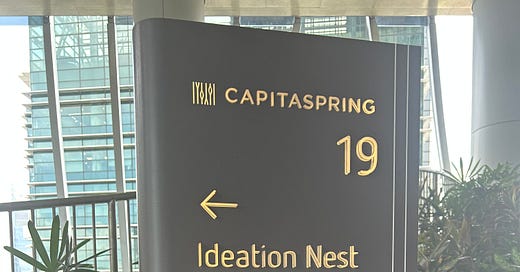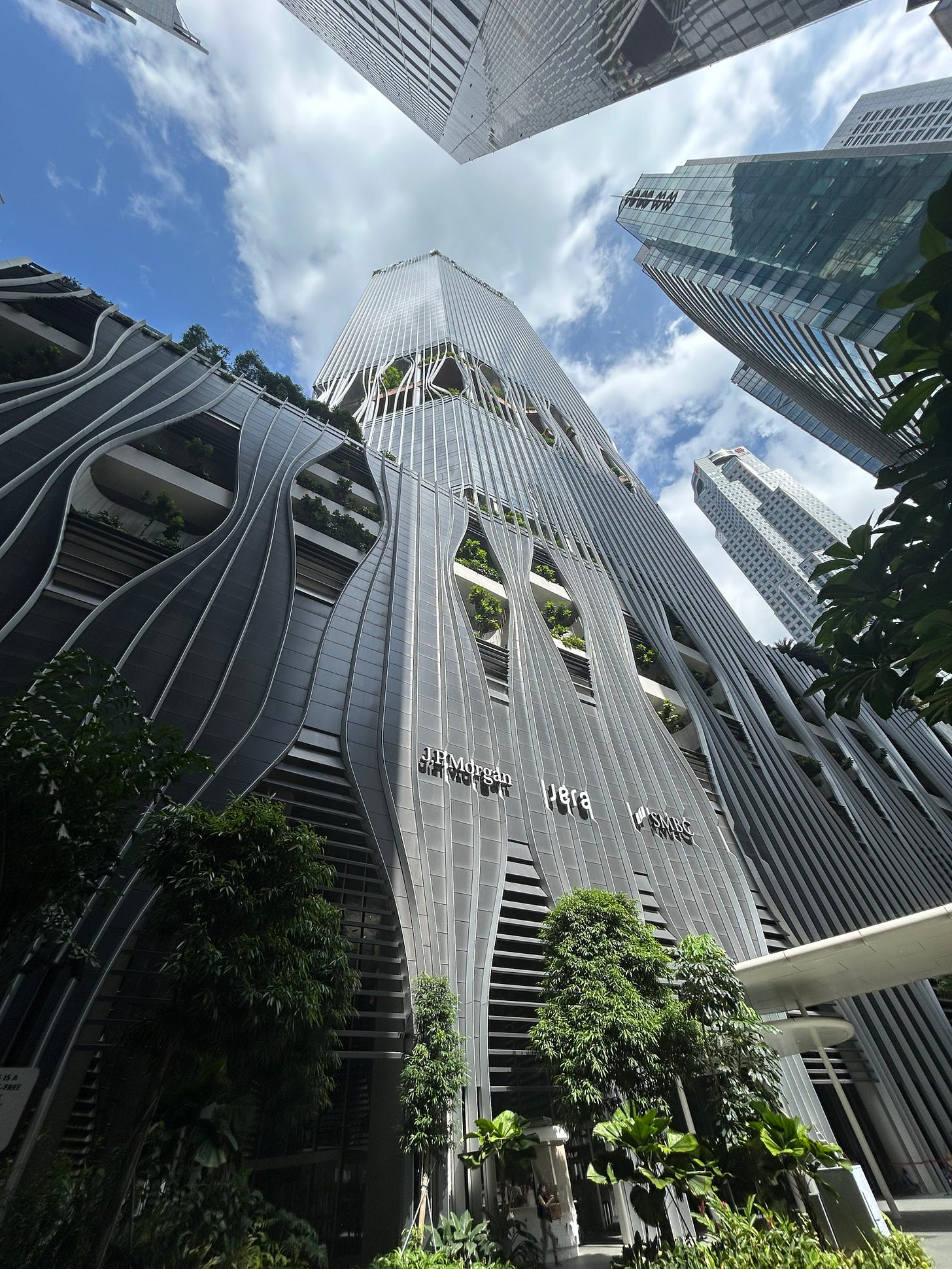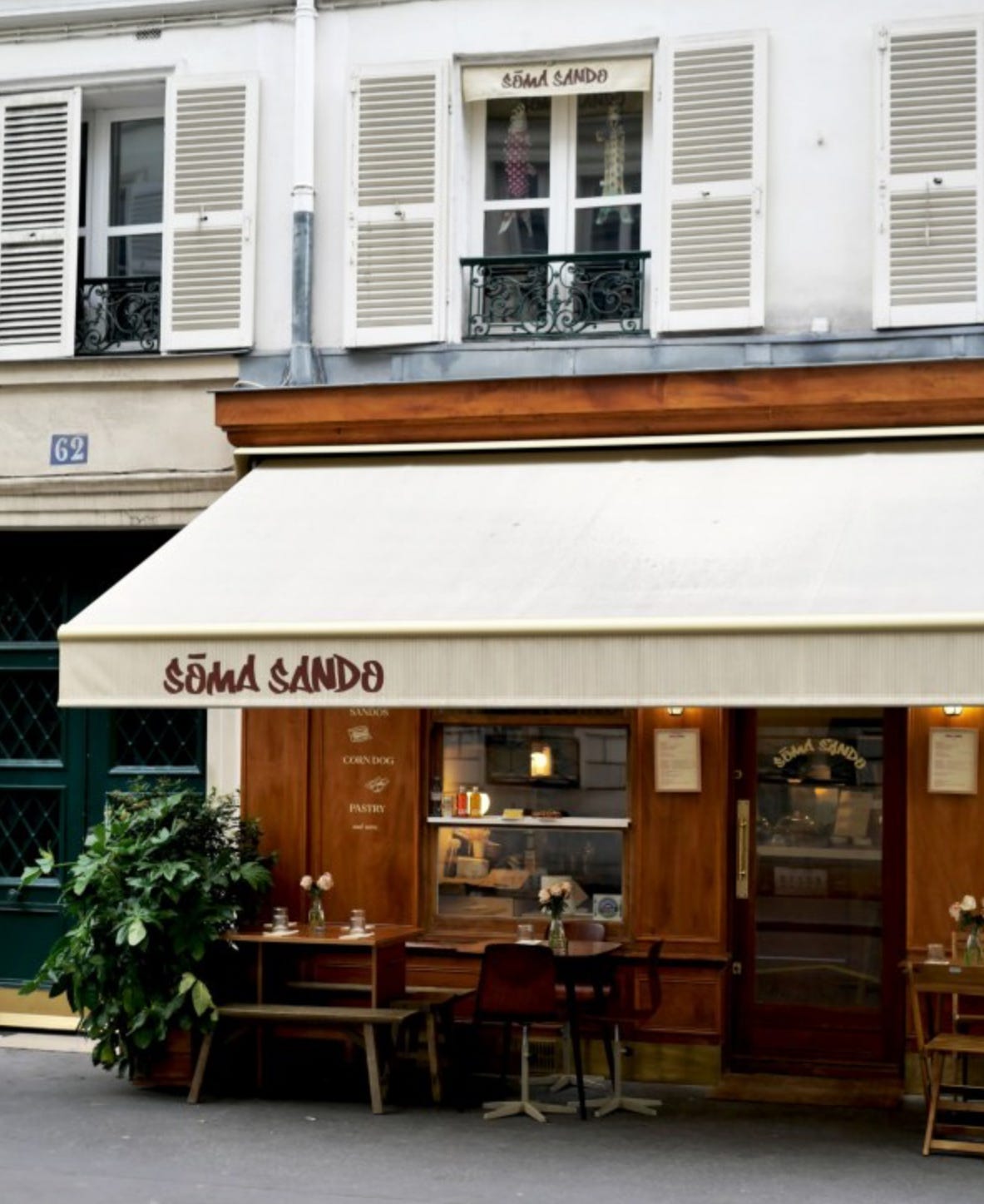Work adventures in Singapore
The psychology of architecture, and Paris falls in love with Japan
Work adventures in Singapore
A few weeks ago I was in Singapore gathering data on a research project.
Unlike Tokyo, where you still need to pay cash more often than you would imagine and ATMs are scarce (along with rubbish bins), in Singapore everything is engineered to a mind-blowing degree.
There are lines prescribing precisely where you should stand while waiting to board the metro. I received disapproving looks all week because I am much too preoccupied to notice these things (or actually, just not that great at following rules).
As I exit the station, a sign near a large rack of e-bikes for hire advises that taking one illegally may result in three years in prison.
Where I live, the e-bike hire company stations them in random places all over the city hoping desperately that someone will use one. They almost invite you to commandeer one to ride home after too many drinks (even though this seems like a terrible idea for people who probably haven’t ridden a bike for decades).
Back to the engineering bit.
A recent introduction into train stations, shopping centres and office buildings throughout Singapore are on-the-go health kiosks where commuters can check their blood pressure, heart rate, BMI, body fat percentage analysis, oxygen sats, and level of fatigue. The pods are designed to be user-friendly with touchscreen interfaces and provide wellness recommendations based on your results.
Ben, my research partner at JLL was extremely excited by this new installation. By his own admission, as head of innovation, he’s intensely willing to submit to almost any invasive new technology just to try it out.
I on the other hand, recoiled visibly as he showed off his textbook perfect stats. No no, I responded when he suggested I try it out. As a recovered (let’s be honest here, trying not to relapse) perfectionist, the anxiety of not getting the right scores would probably increase my heart rate to well over 100.
But the greenery everywhere you turn in Singapore is stunningly beautiful (and very calming).The efficiency and convenience of every single thing made my impatient nature very happy.
Getting to spend time doing research in buildings like the one here at Capita Springs is an immense pleasure. It has a four story garden in the centre of the building with a jungle gym, ideation nest, a gorgeous restaurant and paths that encourage you to meander slowly through the greenery. All office buildings should be like this and Singapore are leading the world at biophilic design.
We have three studies underway which I can’t wait to share with you soon. In the first one which we are now writing up for publication, we used big data methodology to analyse over three million data points from JLL offices around the world. The insights on how we use offices and the kinds of spaces we gravitate to from such a big data set (and a methodological contribution from my co-author Dr James Todd) are fascinating.
Beyond the beauty of biophilic design, my recent podcast guest Michal Matlon talks about why creating lots of different spaces that bring people together matters now more than ever.
No, we don’t need to do it every day, but meaningful connection (not forcing your coworkers to have pizza nights in the office) and serendipity matter, and can be scaffolded by intentionally curated spaces.
Michal is an architectural psychologist and co-founder of the wonderful Venetian Letter. You can listen to the episode here on Apple on Spotify.
Paris falls in love with Japan
In Paris, a new Japan loving generation is leading a movement to combine the French love of bread with Japanese cuisine. Aside from sharing an obsession for food with Japan, France is also the biggest overseas market for manga and Europe’s biggest consumer of sushi.
The French are bread obsessed. Six billion baguettes are sold there every year. Japan, not so much. Bread doesn’t feature in their traditional cuisine. In fact the word for bread is in katakana, the part of Japanese language reserved for words of non-Japanese or technical origin.
Bread in Japan is called pan from the Portuguese who introduced bread to Japan when one of their trading vessels was shipwrecked off the coast of Kyushu in 1543. Incidentally, this event marked the first direct contact between Japanese people and Europeans.
I’m heading to Japan for work in a couple of weeks. I am also learning French, so I was very happy to learn about Soma Sando where they combine shokupan (pillowy Japanese milk bread) with creations spanning wagyu beef, tonkatsu (fried pork) and foie gras terrine.
Paris was already on my list for this year but it just moved up for the chance to experience this.
Libby x
P.S. If you haven’t heard the latest episodes of the podcast with my interview with blockchain pioneer Charles Hoskinson, you can watch here or listen here.
P.P.S. Next week, I’m writing about post-it notes and why analogue matters so much for cognition and ideas.
P.P.P.S And next Friday Harvard Professor Raj Choudhury is on the podcast talking about the geography of work, digital twins, and all the evidence about why location flexibility is here to stay (ignore people wielding chainsaws and those who think their personal opinion is the truth for everyone).









I'm not sure what it says about me that I'm so excited for the studies to come out haha.